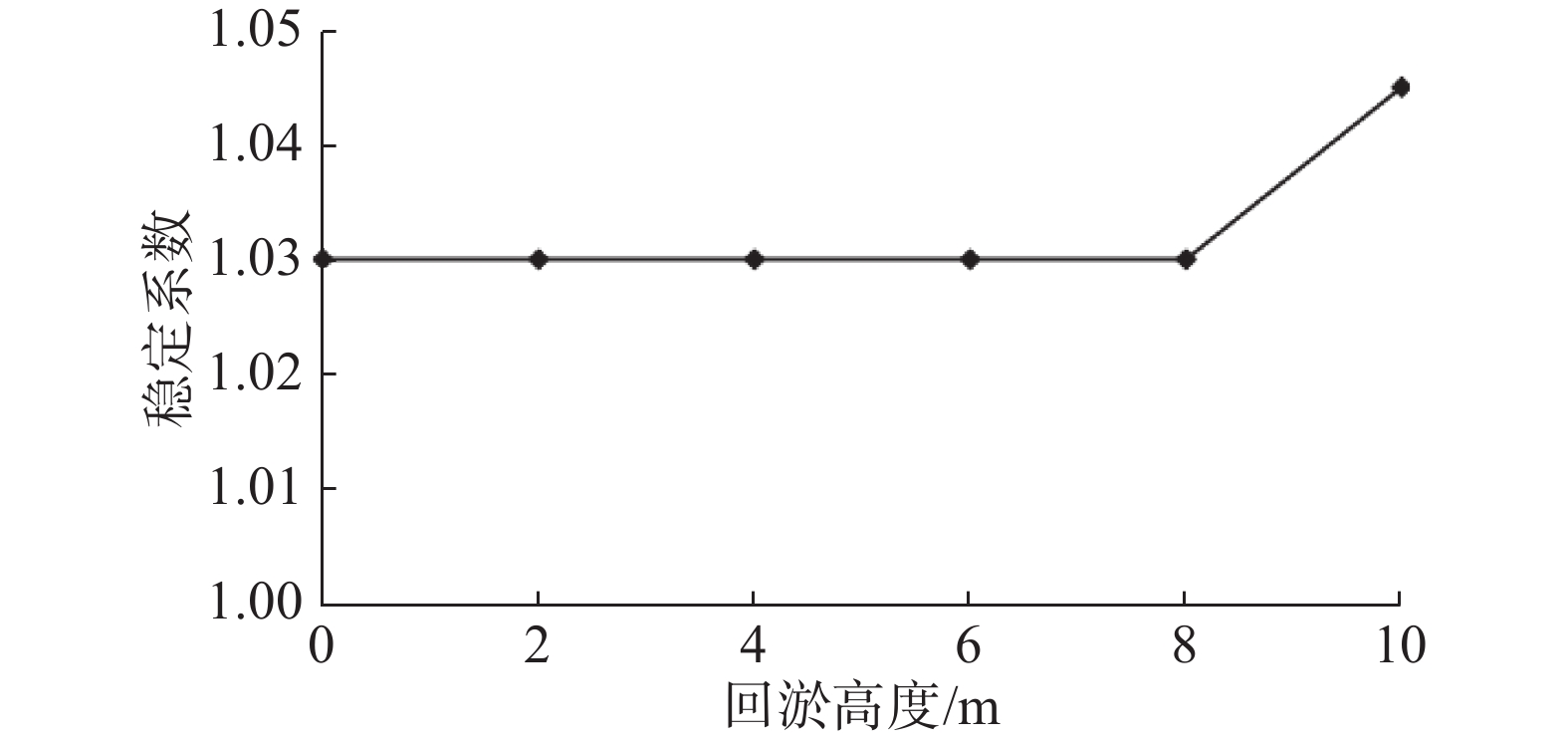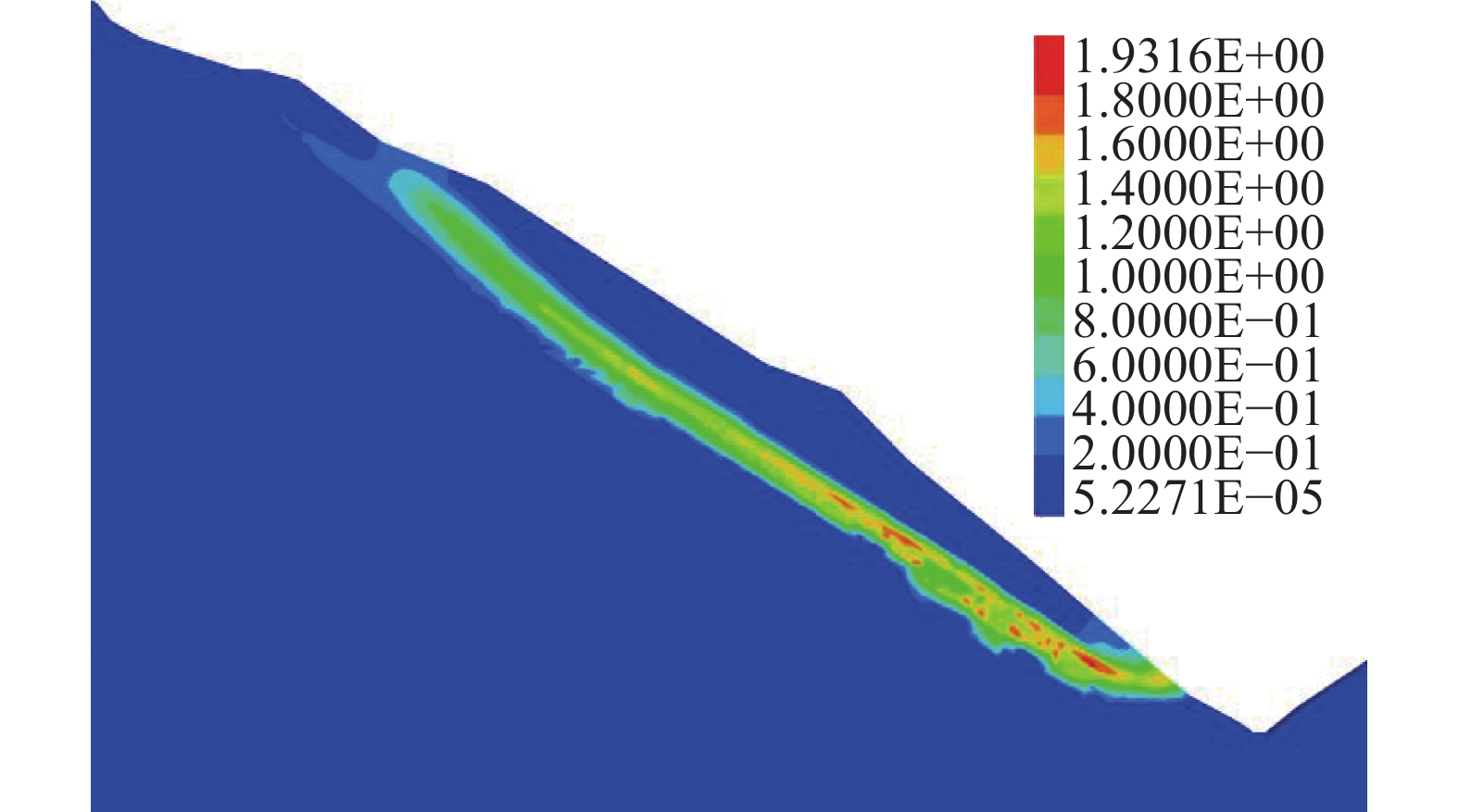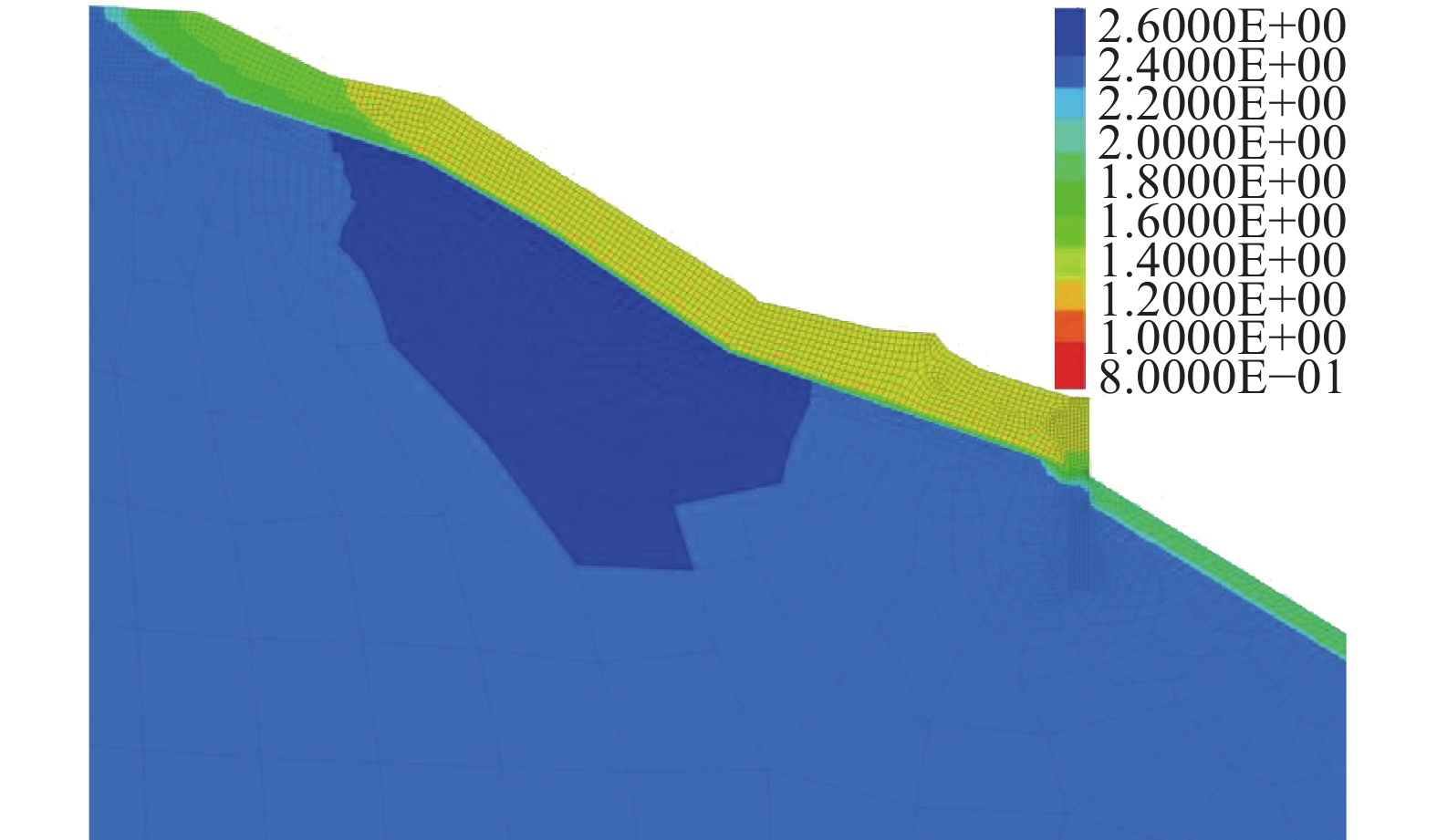Deformation and failure mechanism and analysis on prevention measures of colluction landslide under earthquake and heavy rainfall
-
摘要: 位于西南山地堆积体滑坡常受到地震和强降雨的双重作用,查明此类滑坡变形破坏机理是地质灾害防治和风险防控的基础。文章的研究对象是鲜水河断裂带附近的炉霍县马居滑坡。研究表明,地震作用对位于斜坡地带堆积体滑坡体结构损伤明显,不但使滑坡整体稳定性下降,还促使坡体内裂隙大量发育,利于降雨入渗,进一步恶化滑坡的水文地质条件。强降雨形成的大规模洪水和泥石流下切坡脚沟道,牵引滑坡体整体向下。长历时强降雨入渗影响坡体稳定性,且在降雨结束后较长时间持续影响坡体稳定性。因此,对此类滑坡防治的对策应考虑坡脚防护和抗滑支挡设置。在对防治方案的有效性分析后,表明防护方案在极端条件下仍然能保障安全性,达防治和风险管控的目的。Abstract: Accumulation landslides located in the Southwest Mountainous are affected by both earthquake and heavy rainfall, the deformation and failure characteristics of landslides are affected by these two main factors. Finding out the deformation and failure mechanism of this kind of landslide is the basis of geological disaster prevention and risk prevention and control. This paper takes Maju landslide in Luhuo County as the research object. The results show that, the seismic action has obvious damage effect on the structure of accumulation landslide located in slope zone, it not only reduces the overall stability of the landslide, but also promotes the development of a large number of fissures in the slope, which is conducive to the infiltration of rainfall into the slope, and then worsens the hydrogeological conditions of the landslide. Heavy rainfall is easy to form large-scale flood and debris flow, cutting the gully at the foot of the slope, and pulling the landslide to slide downward as a whole. The long-term heavy rainfall infiltration slope also has a great impact on the stability of the landslide, and the landslide is in an unstable state for a long time after rainfall. Therefore, for this kind of landslide prevention scheme, the strategy of paying equal attention to slope toe protection and anti slide retaining should be adopted, the effectiveness analysis of the protection scheme shows that the safety of the protection scheme has a certain guarantee under extreme conditions, achieves the purpose of prevention and control, and further controls the risk.
-
0. 引言
随着我国公路、铁路等基础设施建设的推进,工程中遇到了大量的岩质边坡崩塌破坏、风化剥落等问题,尤其在西部山区国(省)干道的升级改造过程中,这种现象最为严重[1-5]。由于山区道路地形地质复杂,地质构造运动剧烈,表层岩体风化剥蚀强烈,多呈碎裂状态。在地震、暴雨及工程开挖卸荷扰动等因素共同作用下,边坡整体稳定性和浅表层稳定性问题共同构成影响道路运营安全的重要因素。
学者们对该类岩质边坡变形破坏开展了大量研究,贺凯等[6]针对高陡岩体底部压裂失稳模式,提出了考虑底部薄弱区域损伤演化的边坡整体稳定性评价方法。张科等[7]基于运动单元法对岩质边坡复合型破坏机制进行研究表明,岩桥位置、结构面贯通度和结构面倾角是控制力学行为的三个主要因素。罗洪成等[8]利用现场勘测和数值模拟方法分析了富水破碎岩质边坡的滑坡成因和特征,指出岩体后缘拉裂引起前部剪切破坏,最后导致边坡整体失稳。张广甫等[9]基于贯通率法对危岩主控结构面主要强度参数、值取值进行了研究。严豪等[10]基于Voronoi节理模型分析了碎裂岩质边坡破坏是从坡顶以一定深度向坡脚贯通发展的。徐前卫等[11]通过室内模型试验总结出坡顶岩体张拉破坏与坡脚岩体压剪破坏共同造成直立软弱破碎岩质边坡塌方,具有渐进性特征。霍宇翔等[12]通过对碎裂岩质边坡监测表明,稳定性由多组相交结构面控制,受结构面产状及分布规律影响较大。曹兴松[13]则通过分析碎裂岩质边坡病害特征,总结出边坡破坏模式、形成机制和失稳过程,指出边坡高陡、岩体风化及降雨软化等是主要影响因素。
由此可知,目前对岩质边坡研究,多集中于边坡整体稳定性加固防护方面,设计治理也多采用框架或垫墩锚索等[14-16]。针对边坡浅表层岩土体失稳,多在坡表采用与短锚杆相结合的SNS主动防护网进行加固[17-19](图1)。
对破碎岩质边坡浅表层岩体防护,通常采用SNS主动防护网[17-18]。即通过3~4 m长的短锚杆将主动防护网固定于坡面上,通常锚杆拉力不超过50 kN。实际上,此类短锚杆并不能为边坡提供足够的锚固力,一旦坡体发生整体失稳,难以起到加固作用,并不是严格意义上的主动防护。现阶段对SNS主动防护网的研究主要为工程应用介绍及防护效果评价,对其防护作用机理及受力特点也多局限于单元网格结构受力分析[18-20]。
综上,目前针对深层加固的锚索+浅层防护的SNS主动防护网的联合协同受力研究较少。基于此,本文提出锚墩式主动防护网新型结构设计方法,以有效克服山区破碎岩质边坡加固防护难题。
1. 锚墩式主动防护网组合结构
1.1 锚墩式主动防护网结构组成
锚墩式主动防护网的突出特点在于:在主动防护网结构的节点处设置垫墩锚索代替传统的短锚杆,以实现该结构对边坡的深层加固(图2)。
其结构主要由以下部分组成:横向支撑绳①、纵向支撑绳②、缝合绳③、高强度钢绳网④、锚墩⑤、加固锚索⑥及固定短锚杆⑦。
其特征是:设置于坡顶与坡脚处的固定短锚杆主要起定位高强度钢绳网的作用。设置于网格节点处的锚墩和加固锚索,锚墩与网格节点处的纵向支撑绳、横向支撑绳形成固定连接,加固锚索则穿越坡体内潜在深层滑动面锚入稳定基岩体中,主要起到深层加固作用。高强度钢绳网呈曲面状铺设于坡面,通过缝合绳与网格周边的纵向支撑绳、横向支撑绳连接,并分隔成网格状。通过向张拉缝合绳与支撑绳施加作用力对高强度钢绳网进行预张拉,主要起到表层防护作用。
工程应用中的支撑绳与缝合绳应选用满足工程使用年限的钢丝绳(如磷化涂层钢丝绳),当需对锚墩间主动防护网单元进行破损置换或修补时,可通过解开缝合绳将主动防护网与支撑绳进行分离。
为防止水泥锚墩与主动防护网中支撑绳之间因压缩产生磨损及切割作用[21],在锚墩接触面处单独设立双层硬橡胶垫片或双层尼龙垫片(图3)。在支撑绳受力时,通过给予足够的变形空间,使得锚墩与支撑绳之间能够变形协调,保护主动防护网结构不产生切割破坏。
1.2 锚墩式主动防护网加固机理
加固锚索前端通过锚墩作用于坡面之上,后端则穿越坡体内潜在深层滑动面,锚入稳定基岩体之中。通过对锚索施加预应力进行边坡加固,可有效提高边坡稳定性,防止产生整体失稳破坏。
高强度钢绳网覆盖岩质边坡坡面,利用钢丝绳的预张拉作用力及粗糙坡面之间的摩擦力,可阻止破碎岩质边坡锚墩间岩土体向外侧的移动,有效的加固区域内边坡浅表层破碎块体,防止发生局部块体崩落。
由此可知,锚墩式主动防护网能同时解决边坡整体失稳与浅表层失稳问题,是山区道路破碎岩质边坡工程中行之有效的主动防护结构。
2. 锚墩式主动防护网设计方法
2.1 设计计算模型
在锚墩式主动防护网中以相邻的4个锚墩所围成的封闭区域作为研究对象,将其视为一个防护网格单元(图2)。在进行锚墩式主动防护网设计时,根据边坡浅表层岩体情况,在计算表层岩土体失稳带来的锚索轴力增量时,可按以下两种情况进行考虑。
(1)若单元格内有可探明结构和力学参数的危岩体,则可按图4所示力学模型进行计算。设危岩体主控结构面水平夹角为
${\beta _1}$ (°),黏聚力为${c_1}$ (kN/m2),内摩擦角为${\varphi _1}$ (°),竖向高度为${H_1}$ (m),岩体单宽自重为${G_1}$ (kN/m)。结构面处稳定岩体对危岩体的单宽作用力为${N_1}$ (kN/m)。主动防护网加固浅表层岩体的分布力为${q_1}$ (kN/m2),由于钢绳网为柔性结构,可将其等效于一个水平夹角为${\theta _1}$ (°)的单宽合力${F_1}$ (kN/m)。破碎岩质边坡,具有高陡、易风化等特点,在岩体风化作用下结构面裂隙不断扩展,边坡失稳主要表现为产生水平向外的位移[22-25],为了简化分析,可取${\theta _1}$ 为0°。根据危岩体稳定性计算方法,安全系数
${F_{\rm{s}}}$ ,可按公式(1)进行计算。$${F_{\rm{s}}} = \frac{{{F_1}\cos {\beta _1} + \left( {{G_1}\cos {\beta _1} + {F_1}\sin {\beta _1}} \right)\tan {\varphi _1} + {c_1}\dfrac{{{H_1}}}{{\sin {\beta _1}}}}}{{{G_1}\sin {\beta _1}}}$$ (1) 式中:
${c_1}$ ——危岩体结构面黏聚力/(kN·m−2);${\varphi _1}$ ——危岩体结构面内摩擦角/(°);${\beta _1}$ ——危岩体主控结构面水平夹角/(°);${H_1}$ ——危岩体竖向高度/m;${G_1}$ ——危岩体单宽自重/(kN·m−1);${F_1}$ ——钢绳网单宽作用力合力/(kN·m−1)。按规范要求确定安全系数
${F_{\rm{s}}}$ 后,钢绳网单宽作用力合力${F_1}$ ,可按式(2)进行反算:$${F_1} = \frac{{{F_{\rm{s}}}{G_1}{{\sin }^2}{\beta _1}{\rm{ - }}{G_1}\sin {\beta _1}\cos {\beta _1}\tan {\varphi _1} - {c_1}{H_1}}}{{\sin {\beta _1}\cos {\beta _1} + {{\sin }^2}{\beta _1}\tan {\varphi _1}}}$$ (2) 根据静力平衡条件可知,主动防护网通过锚索提供的锚固力和边坡浅表层岩土体对主动防护网的作用力是一对平衡力。如图2所示,设锚索间距为水平间距B1(m)×沿坡面竖向间距
${H_1}$ (m),考虑到每个单元格内有4束锚索共同作用(每束锚索为4个单元格提供锚固力),由图5可知,每束锚索由边坡浅表层失稳带来的轴力增量$\Delta {f_1}$ (kN),可按公式(3)进行计算。$$\Delta {f_1} = \frac{1}{4} \cdot \frac{{{B_1}{F_1}}}{{\cos {\alpha _1}}} \cdot 4 = \frac{{{B_1}{F_1}}}{{\cos {\alpha _1}}}$$ (3) 式中:
${\alpha _1}$ ——锚索的锚固角/(°);B1——锚索水平间距/m。
(2)若单元格内岩体无明显主控结构面或为坡面较为完整的高陡切方岩质边坡,则可按图6所示力学模型进行计算。通过在网格节点的锚墩位置处作两条与锚索夹角为45°+φ2
/2的作用线,由坡面线与两条作用线所围成区域即为边坡浅表层潜在不稳定滑体部分。 此时,可参照地基基础设计计算,通过对锚索施加预应力,锚墩会对坡面产生作用力,可将锚墩作为一个方形基础考虑。如图7(a)所示,根据硬质土整体剪切破坏模式,当荷载达到某一数值时,基础边缘土体先发生剪切破坏,随着荷载增加,破坏区不断扩大,最后形成连续滑动面,导致基底土体向四周挤出,产生整体失稳破坏。如图7(b)所示,地基中Ⅰ区为三角形压密区,该区岩土体直接受压并向两侧挤压,称为主动区;Ⅱ区为被动变形区,该区岩土体受Ⅰ区挤压产生被动变形,称为被动区;基础底部外侧Ⅲ区,由于有临空面为三角形极限平衡区。根据摩尔应力圆图(图7c),Ⅰ区与Ⅱ区分界面AC和BC与基础底面AB(大主应力作用面)的夹角为45°+ φ 2 /2;Ⅱ区与Ⅲ区分界面AE(DE)和BE'(D'E')与临空面AD、BD'(小主应力作用面)的夹角为45°−φ 2/2。
根据以上分析可知,将锚墩视作方形基础后,锚索锚固力作用方向即为大主应力方向。如图6所示,由坡面线与锚索夹角为45°的两条作用线所围成的是锚墩外侧受挤压的潜在不稳定岩土体区域,即为图7(b)中的Ⅲ区。在进行锚墩式主动防护网设计时,需考虑该区域浅表层岩土体失稳带来的锚索轴力增量影响。
划定潜在滑体范围后(图6),各参数设置及简化计算假定与情况1相同,同理安全系数
${F_{\rm{s}}}$ 计算公式为:$${F_{\rm{s}}} = \frac{{{F_2}\cos {\beta _2} + \left( {{G_2}\cos {\beta _2} + {F_2}\sin {\beta _2}} \right)\tan {\varphi _2} + {c_2}{L_2}}}{{{G_2}\sin {\beta _2}}}$$ (4) 其中:
${L_2} = \dfrac{{{H_2}}}{2}\left( {\dfrac{1}{{\cos {\theta _1}}} + \dfrac{1}{{\cos {\theta _2}}}} \right)$ ,${\theta _1} = 45^\circ - \dfrac{{{\varphi _2}}}{2} - \delta$ ,${\theta _2} = 45^\circ - \dfrac{{{\varphi _2}}}{2} + \delta$ ;式中:
${F_2}$ ——钢绳网单宽作用力合力/(kN·m−1);${\,\beta _2}$ ——潜在滑体滑动面水平夹角/(°);${G_2}$ ——潜在滑体单宽自重/(kN·m−1);${\varphi _2}$ ——潜在滑面内摩擦角/(°);${c_2}$ ——潜在滑面黏聚力/(k·Nm-2);${L_2}$ ——潜在滑体滑动面长度/m;${H_2}$ ——潜在滑体沿坡面竖向高度/m;${\theta _1}$ ——下部潜在滑面与坡面的夹角/(°);${\theta _2}$ ——上部潜在滑面与坡面的夹角/(°);$\delta $ ——坡面线与锚索法向线的夹角/(°)。按规范要求确定安全系数
${F_{\rm{s}}}$ 后,钢绳网单宽作用力合力${F_2}$ ,可按式(4)进行反算:$${F_2} = \frac{{{F_{\rm{s}}}{G_2}{{\sin }^2}{\beta _2} - {G_2}\sin {\beta _2}\cos {\beta _2}\tan {\varphi _2} - {c_2}{L_2}\sin {\beta _2}}}{{\sin {\beta _2}\cos {\beta _2} + {{\sin }^2}{\beta _2}\tan {\varphi _2}}}$$ (5) 同理可得每束锚索由边坡浅表层失稳带来的轴力增量
$\Delta {f_2}$ (kN)的计算公式:$$\Delta {f_2} = \frac{1}{4} \cdot \frac{{{B_2}{F_2}}}{{\cos {\alpha _2}}} \cdot 4 = \frac{{{B_2}{F_2}}}{{\cos {\alpha _2}}}$$ (6) 式中:
${\alpha _2}$ ——锚索的锚固角/(°);B2——锚索水平间距/m。
由上可知,锚墩式主动防护网加固设计关键在于确定浅表层潜在不稳定岩土体范围。根据边坡稳定性设计要求,计算出加固该区域岩土体的所需的锚固力。并将该部分锚固力计入主体防护结构,如预应力锚索的锚固力设计中。
2.2 设计计算步骤
为使锚墩式主动防护网新型组合结构加固边坡实现受力协调,提出以下设计计算步骤(图8)。
(1)边坡加固适用性论证
根据边坡地质条件勘察报告,评估锚墩式主动防护网加固的适用性。
(2)边坡稳定性分析
根据规范要求的设计安全系数,通过对预加固边坡进行稳定性分析计算,获得以下结果:
①确定锚索布置及初始锚固力
${P_0}$ 通过边坡整体滑动稳定性分析,计算剩余下滑力,确定锚索布设位置、间距、锚固角及初始锚固预应力
${P_0}$ 。②确定主动防护网受力
$F$ 通过边坡浅表层地质情况结合锚索布置,确定每个防护单元内岩土体浅表层滑动破坏区域,进行坡面稳定性分析,计算主动防护网结构受力
$F$ 。(3)计算锚索预应力
${P_{\rm{t}}}$ 通过主动防护网受力
$F$ ,计算作用在锚索上的轴力增量$\Delta f$ ,确定锚索预应力${P_{\rm{t}}} = {P_0} + \Delta f$ 。(4)锚墩式主动防护网设计
在锚索布置间距和主动防护网单元尺寸大小,结构受力等情况明确的条件下进行锚墩式主动防护网设计。
3. 工程设计实例
3.1 边坡概况
实例边坡位于中江县太安镇境内,在沪蓉高速南充至成都扩建段K1 895+750—K1 895+860(双向4车道扩建为8车道)左侧,长约110 m。边坡属浅丘地貌,覆盖层很薄,层厚约0.5~1 m;下伏基岩为侏罗系上统蓬莱镇组(J3p)粉砂质泥岩、砂岩,产状:321°∠7°。钻孔揭示厚度达35 m,其中强风化带厚2~5 m,强卸荷带厚3~7 m。表层岩体破碎、裂隙密集、岩芯多呈薄片状,无明显主控结构面,且粉砂质泥岩具有饱水软化、失水开裂特性。原挖方边坡高度约47 m,采用缓坡比+宽平台方式开挖(综合坡比1∶1.0~1∶1.25),泥岩段采用护面墙进行护面(图9)。
3.2 边坡扩挖防护设计
本段路基为双侧加宽段,其单侧加宽3.75×2=7.5 m。设计采用陡坡比+强措施进行开挖收坡,经计算边坡坡脚开挖后,存在整体失稳风险,需进行加固防护。由3.1节可知,开挖坡面位于卸荷裂隙密集的强风化带内,同时应防止浅表层坡体发生失稳破坏。为防止边坡二次开挖失稳,设计第一级边坡采用框架锚杆防护,第二、三级边坡采用锚墩式主动防护网防护(图9)。
采用锚索间距4 m×3 m,锚固角20°,坡比1∶0.75,岩体参数:
$\gamma $ =21 kN/m3,$c$ =8 kN/m2,$\varphi $ =25°;经计算设计初始锚固力${P_0}$ =637.17 kN,主动防护网作用力$F$ =103.26 kN,锚索轴力增量$\Delta f$ =112.49 kN,锚索锚固力${P_{\rm{t}}}$ =740.43 kN。设计锚索采用6根$\varnothing^{\rm{S}} $ 15.24低松弛钢绞线(1860 MPa级),锚索长18~25 m,锚固段长10 m,满足边坡整体及浅表层加固设计要求。通过以上计算得出,由浅表层岩体失稳带来的锚索轴力增量可达到初始锚索轴力的15%~20%,这将使防护结构偏于不安全;因此,在高陡破碎岩质边坡加固设计中应考虑这一影响因素。
3.3 边坡施工及工后状况
如图10所示,施工后主动防护网结构与锚墩形成固定连接,共同对边坡进行防护。
根据工后边坡观测及坡面调查,由于锚索设计时考虑了主动防护网对其产生的锚固力增量,边坡整体稳定性良好。高强度钢绳网覆盖整个加固区坡面,经调查坡表未出现局部块体崩塌、滑移等地质灾害现象,边坡整体防护加固效果良好。
4. 结论
(1)锚墩式主动防护网新型结构将预应力锚索与主动防护网有效联合,实现二者协同受力,可同时完成碎裂岩质边坡的整体加固和坡面防护。
(2)锚墩式主动防护网中主动网的受力应为预应力锚索加固后锚墩间坡面局部岩土体的作用力,局部岩土体的上、下边界分别与坡面呈
$45^\circ - \varphi /2 + \delta $ 、$45^\circ - \varphi /2 - \delta $ 的夹角。预应力锚索的受力除了应满足边坡整体稳定外,还应将主动网受力计入。(3)锚索预应力设计时宜考虑15%~20%的预留量,以应对坡面岩土体在地震或暴雨等条件下对主动网的张拉。
-
图 1 研究区地震断裂及历史地震分布图[4]
Figure 1. Distribution map of seismic faults and historical earthquakes in the study area
表 1 滑坡区主要岩土参数表
Table 1 Geotechnical parameters of landslide area
岩土体 体积模量/MPa 剪变模量
/MPa天然状态 饱和状态 重度/(t·m−3) 内聚力/kPa 内摩擦角/(°) 重度/(t·m−3) 内聚力/kPa 内摩擦角/(°) 滑坡体 15.60 5.18 2.01 24.3 30.8 2.05 22.9 27.8 强风化 15.20 7.80 22 40 35 - - - 中风化基岩 20.00 12.00 27 1900 42.8 - - - -
[1] 黄润秋. 汶川地震地质灾害后效应分析[J]. 工程地质学报,2011,19(2):145 − 151. [HUANG Runqiu. After effect of geohazards induced by the Wenchuan earthquake[J]. Journal of Engineering Geology,2011,19(2):145 − 151. (in Chinese with English abstract) DOI: 10.3969/j.issn.1004-9665.2011.02.001 [2] 于宝国, 边波, 李春龙, 等. 基于知识图谱的碎石土堆积体滑坡研究热点及发展趋势[J]. 地球科学前沿(汉斯),2021(10):1326 − 1340. [YU Baoguo, BIAN Bo, LI Chunlong, et al. Research hotspot and development trend of gravel soil accumulation landslide based on knowledge graph[J]. Advances in Geosciences,2021(10):1326 − 1340. (in Chinese with English abstract) [3] 孙凯, 孟国杰, 洪顺英, 等. 联合InSAR和GPS研究鲜水河断裂带炉霍—道孚段震间运动特征[J]. 地球物理学报,2021,64(7):2278 − 2296. [SUN Kai, MENG Guojie, HONG Shunying, et al. Interseismic movement along the Luhuo-Daofu section of the Xianshuihe Fault from InSAR and GPS observations[J]. Chinese Journal of Geophysics,2021,64(7):2278 − 2296. (in Chinese with English abstract) [4] 中国地震台网中心国家地震科学数据中心. http://data.earthquake.cn China Seismological Network Center National Seismological Science Data Center.http://data.earthquake.cn.(in Chinese)
[5] 赵金, 吴红刚, 杨涛. 滑坡对不同特性地震波的动力响应规律[J]. 中国地质灾害与防治学报,2018,29(6):47 − 52. [ZHAO Jin, WU Honggang, YANG Tao. Dynamic response of landslides to different seismic wave[J]. The Chinese Journal of Geological Hazard and Control,2018,29(6):47 − 52. (in Chinese with English abstract) [6] 丁秀美, 刘光士, 黄润秋, 等. 剪应变增量在堆积体边坡稳定性研究中的应用[J]. 地球科学进展,2009,19(增刊 1):318 − 323. [DING Xiumei, LIU Guangshi, HUANG Runqiu, et al. Shear strain increment applying instability studying of debris slope[J]. Advance in Earth Sciences,2009,19(Sup 1):318 − 323. (in Chinese with English abstract) [7] 李秀珍, 何思明. 基于Mein-Larson入渗模型的浅层降雨滑坡稳定性研究[J]. 灾害学,2015,30(2):16 − 20. [LI Xiuzhen, HE Siming. A study on stability of shallow rainfall-induced landslide based on mein-larson infiltration model[J]. Journal of Catastrophology,2015,30(2):16 − 20. (in Chinese with English abstract) [8] 杨宗佶, 蔡焕, 雷小芹, 等. 非饱和地震滑坡堆积体降雨破坏水-力耦合行为试验[J]. 岩土力学,2019,40(5):1869 − 1880. [YANG Zongji, CAI Huan, LEI Xiaoqin, et al. Experiment on hydro-mechanical behavior of unsaturated gravelly soil slope[J]. Rock and Soil Mechanics,2019,40(5):1869 − 1880. (in Chinese with English abstract) [9] 邹祖银, 朱占元, 张锋, 等. 连续降雨条件下某震后高边坡稳定性分析[J]. 地震工程学报,2016,38(4):541 − 548. [ZOU Zuyin, ZHU Zhanyuan, ZHANG Feng, et al. Stability analysis of post-earthquake high slope under continuous rainfall[J]. China Earthquake Engineering Journal,2016,38(4):541 − 548. (in Chinese with English abstract) [10] 贺小黑, 彭鑫, 谭建民, 等. 地下水渗流对崩坡积滑坡稳定性和变形的影响: 以湖南安化春风滑坡群为例[J]. 中国地质灾害与防治学报,2020,31(6):96 − 103. [HE Xiaohei, PENG Xin, TAN Jianmin, et al. Influence of groundwater seepage on stability and deformation of colluvial deposit landslide: Taking Chunfeng Landslide group in Anhua County of Hunan Province as an example[J]. The Chinese Journal of Geological Hazard and Control,2020,31(6):96 − 103. (in Chinese with English abstract) [11] 韩培锋, 樊晓一, 田述军, 等. 降雨强度与含石量对松散堆积体失稳影响研究[J]. 工程科学与技术,2019,51(1):112 − 120. [HAN Peifeng, FAN Xiaoyi, TIAN Shujun, et al. Effect of rainfall intensity and stone content on the instability of quaternary deposits[J]. Advanced Engineering Sciences,2019,51(1):112 − 120. (in Chinese with English abstract) [12] 王家柱, 葛华, 高延超, 等. 川南红层区黄子树滑坡形成过程与运动特征[J]. 中国地质灾害与防治学报,2020,31(2):9 − 17. [WANG Jiazhu, GE Hua, GAO Yanchao, et al. Mechanism and kinematic characteristics of Huangzishu Landslide in the red mudstone of southern Sichuan[J]. The Chinese Journal of Geological Hazard and Control,2020,31(2):9 − 17. (in Chinese with English abstract) [13] 吴火珍, 冯美果, 焦玉勇, 等. 降雨条件下堆积层滑坡体滑动机制分析[J]. 岩土力学,2010,31(增刊 1):324 − 329. [WU Huozhen, FENG Meiguo, JIAO Yuyong, et al. Analysis of sliding mechanism of accumulation horizon landslide under rainfall condition[J]. Rock and Soil Mechanics,2010,31(Sup 1):324 − 329. (in Chinese with English abstract) [14] 刘明扬, 武哲, 付晓东, 等. 不同降雨条件下堆积体边坡响应规律与失稳力学机制分析[J]. 科技和产业,2021,21(7):266 − 274. [LIU Mingyang, WU Zhe, FU Xiaodong, et al. Analysis of response law and instability mechanism of accumulation slope under different rainfall conditions[J]. Science Technology and Industry,2021,21(7):266 − 274. (in Chinese with English abstract) [15] 廖军, 邓涛, 周越良, 等. 降雨作用下第四系堆积体路堤稳定性[J]. 科学技术与工程,2021,21(23):10090 − 10097. [LIAO Jun, DENG Tao, ZHOU Yueliang, et al. Stability of quaternary accumulation embankment under rainfall[J]. Science Technology and Engineering,2021,21(23):10090 − 10097. (in Chinese with English abstract) [16] 张雨林, 石惊涛, 涂国祥, 等. 粗、巨颗粒富集位置对堆积体降雨入渗的影响[J]. 水利水运工程学报,2021,5:76 − 83. [ZHANG Yulin, SHI Jingtao, TU Guoxiang, et al. Influence of coarse and giant particles enrichment position on rainfall infiltration of accumulation body[J]. Hydro-Science and Engineering,2021,5:76 − 83. (in Chinese with English abstract) [17] 张国帅, 王晓亮, 夏建新. 入渗条件下颗粒堆积体稳定性试验研究[J]. 泥沙研究,2021,46(5):68 − 73. [ZHANG Guo-shuai, WANG Xiaoliang, XIA Jianxin. Experimental study on stability of particle accumulation under infiltration[J]. Journal of Sediment Research,2021,46(5):68 − 73. (in Chinese with English abstract) [18] 张玉, 徐卫亚, 邹丽芳, 等. 降雨条件下大型滑坡体渗流稳定性分析[J]. 岩土力学,2013,34(3):833 − 841. [ZHANG Yu, XU Weiya, ZOU Lifang, et al. Analysis of seepage stability of large-scale landslide under rainfall condition[J]. Rock and Soil Mechanics,2013,34(3):833 − 841. (in Chinese with English abstract) [19] 左自波, 张璐璐, 王建华. 降雨触发不同级配堆积体滑坡模型试验研究[J]. 岩土工程学报,2015,37(7):1319 − 1327. [ZUO Zibo, ZHANG Lulu, WANG Jianhua. Model tests on rainfall-induced colluvium landslides: effects of particle-size distribution[J]. Chinese Journal of Geotechnical Engineering,2015,37(7):1319 − 1327. (in Chinese with English abstract) [20] 卫童瑶, 殷跃平, 高杨, 等. 三峡库区巫山县塔坪H1滑坡变形机制[J]. 水文地质工程地质,2020,47(4):73 − 81. [WEI Tongyao, YIN Yueping, GAO Yang, et al. Deformation mechanism of the Taping H1 landslide in Wushan County in the Three Gorges Reservoir area[J]. Hydrogeology & Engineering Geology,2020,47(4):73 − 81. (in Chinese with English abstract) [21] 穆鹏, 吴玮江, 折学森. 汶川地震重灾区陇南红土坡滑坡稳定性分析与防治对策研究[J]. 工程地质学报,2012,20(2):204 − 212. [MU Peng, WU Weijiang, SHE Xuesen. Stability assessment and treatment for hongtupo landslide in severe disaster area of southern Gansu induced by Wenchuan earthquake[J]. Journal of Engineering Geology,2012,20(2):204 − 212. (in Chinese with English abstract) [22] 张玉, 徐卫亚, 石崇, 等. 争岗滑坡堆积体稳定性及治理措施研究[J]. 岩土工程学报,2010,32(9):1470 − 1478. [ZHANG Yu, XU Weiya, SHI Chong, et al. Stability and treatment of Zhenggang landslide accumulation mass[J]. Chinese Journal of Geotechnical Engineering,2010,32(9):1470 − 1478. (in Chinese with English abstract) -
期刊类型引用(7)
1. 唐晓波. 破碎岩质边坡锚墩式锚索主动防护网的受力研究. 运输经理世界. 2024(14): 139-141 .  百度学术
百度学术
2. 徐志强,杨和平,辛亚兵,张喜伟,师嘉斌,李庭杰. 强风化岩质边坡生态防护技术及应用. 公路与汽运. 2024(06): 56-61+65 .  百度学术
百度学术
3. 王峰,杨雪瑞,刘毅鑫. 陕北地区破碎岩质边坡CBS工艺的试点运用. 交通科技与管理. 2024(24): 133-136 .  百度学术
百度学术
4. 张宁晓,陈茜,林智勇. 基于强度折减法及雷达探测法的破碎岩质边坡的稳定性研究. 有色金属(矿山部分). 2023(04): 58-63 .  百度学术
百度学术
5. 徐平,晏鹏博,董自超. 锚索SNS主动防护网在公路隧道边坡中的应用. 公路. 2023(07): 259-263 .  百度学术
百度学术
6. 张广乾,李向阳,高小航,王伟,张晨招,刘谋. 不稳定块体危岩主动防护网结构计算受力分析与研究. 路基工程. 2023(05): 89-93 .  百度学术
百度学术
7. 吴兵,梁瑶,赵晓彦,李泽洲. 锚墩式主动防护网加固边坡防护效果数值分析. 湖南交通科技. 2023(04): 30-35+41 .  百度学术
百度学术
其他类型引用(0)





 下载:
下载:
























































































 邮件订阅
邮件订阅 RSS
RSS